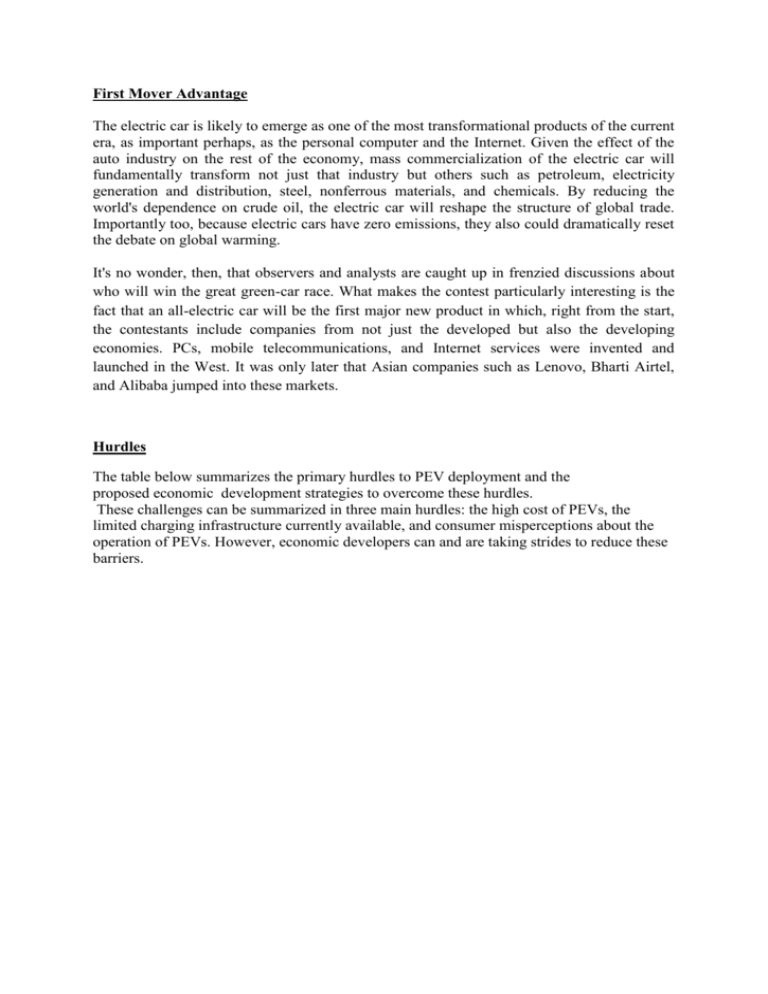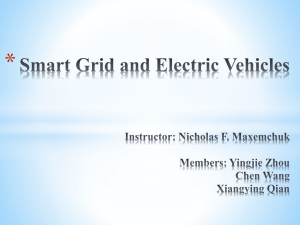First Mover Advantage
advertisement

First Mover Advantage The electric car is likely to emerge as one of the most transformational products of the current era, as important perhaps, as the personal computer and the Internet. Given the effect of the auto industry on the rest of the economy, mass commercialization of the electric car will fundamentally transform not just that industry but others such as petroleum, electricity generation and distribution, steel, nonferrous materials, and chemicals. By reducing the world's dependence on crude oil, the electric car will reshape the structure of global trade. Importantly too, because electric cars have zero emissions, they also could dramatically reset the debate on global warming. It's no wonder, then, that observers and analysts are caught up in frenzied discussions about who will win the great green-car race. What makes the contest particularly interesting is the fact that an all-electric car will be the first major new product in which, right from the start, the contestants include companies from not just the developed but also the developing economies. PCs, mobile telecommunications, and Internet services were invented and launched in the West. It was only later that Asian companies such as Lenovo, Bharti Airtel, and Alibaba jumped into these markets. Hurdles The table below summarizes the primary hurdles to PEV deployment and the proposed economic development strategies to overcome these hurdles. These challenges can be summarized in three main hurdles: the high cost of PEVs, the limited charging infrastructure currently available, and consumer misperceptions about the operation of PEVs. However, economic developers can and are taking strides to reduce these barriers. Although we've made advancements in electric vehicle (EV) technology and adoption in the past few years, uncertainty remains about the future of EVs. Three more major hurdles are given below: 1. Difficult Forecasting Leads Automakers to Hedge Bets Surveys have shown that customers are willing to consider a plug-in electric vehicle (PEV) for their next automobile purchase, with numbers generally in the 50 percent range of respondents Nonetheless, market penetration of more-conventional hybrid electric vehicles (HEV), such as the Toyota Prius, has struggled to break 3 percent of total automobile sales each year. So automakers are hedging their bets on which technologies will win by producing a mix of lightweight, high-MPG combustion engine cars, PHEVs, HEVs and PEVs on the same platform. Ford's C-Max lineup will be one of the first to offer the array of technologies above. By hedging their bets, automakers are using common car platforms to develop battery, drivetrain and lightweighting technologies that need scale to reduce costs without taking a directional bet on one type of electrified car. 2. We Can't Do This Alone -- Help Is Welcome The proliferation of electrified vehicles on a global scale will take more than the traditional automakers and their traditional supplier base. Instead, it will take a constellation of industry players and newcomers to deploy the technologies that support an EV ecosystem. For example, battery suppliers are working to find a breakthrough in energy density, but can only be successful through cooperation. Automakers must adopt the technologies, government policy must support the R&D risks, and utilities need to build the infrastructure necessary to charge enough EVs to make the risks worth taking. Going it alone isn't an option for any one of those stakeholders since the risks and costs associated with each individual piece are high. To create an ecosystem in which electrified vehicles can be successful, many different players will have to work towards the same goals. This leads to the third theme, where collaboration and transparency become far more important than ever before. 3. It's Time for a New Business Model For perhaps the first time in history, automakers and suppliers, utilities, infrastructure developers, financiers, technologists and policymakers are acknowledging that they have shared stakeholders and embracing the interconnectedness of organizations. These many different groups are now sharing common customers in everything they do. It's time for a new business model, where collaboration and competition co-exist. Even traditional rivals see this need for collaboration. Leaders from Ford, GM and Toyota agree that they need to share the risks associated with battery development and standardize charging infrastructure in order to drive down costs and grow the overall EV market. At the same time, individual companies must also compete, as they always have, for share of that market through proprietary application of those new technologies, design and customer service. There appears to be quite a bit of uncertainty on the EV horizon. Out of this uncertainty is springing innovation, collaboration and new business models in an industry more than a century old industry. There will no doubt be winning and losing approaches to electrification, but the journey there will spawn a new way of doing business in India. To sum up, following is the scenario as far as hurdles are concerned: The major challenge is costs. Battery technology is expensive, and because batteries in electric cars need to be able to hold massive amounts of charge to make the cars practical for most drivers, they have to be built using expensive materials, most of which are tough to procure. Because electric cars cost a lot to build, they also cost more than comparable gasoline cars to buy. That makes consumers reluctant to adopt them. It's a free-rangechicken-and-organic-egg problem. Electric cars could be less expensive if electric car makers could ramp up production volume and use economies of scale. But, for that to happen, lots of consumers need to buy electric cars -- something that likely won't happen without prices coming down. Beyond the costs, electric car makers have a lot of convincing to do with consumers. Not everyone is sold on the idea that electric cars make sense for their life. That's because of range anxiety. Electric car makers are finding that people are worried about how far they can travel in electric cars before their batteries peter out. In a gasoline-powered car, running low on gas is really no big deal; just pull into a gas station, fill up and in about five minutes you're back on the road. Charging and electric car isn't quite so simple. Most production electric cars about to hit the market can only go about 100 miles (160.9 kilometers) on a single charge. And, unless you have access to a specialized charging station (which are currently in short supply), getting a full charge takes around eight hours. While most people drive less than 40 miles (64.4 kilometers) a day and could easily charge their electric cars overnight, electric cars still aren't useful for road trips. And, let's say you drive 80 miles (128.7 kilometers) in a day, come home and find out that there's an unexpected emergency and you need to drive another 30 miles (48.3 kilometers)? Consumers thinking of situations like that make for a big hurdle that electric cars still have to clear. Those charging stations are another challenge -- they can alleviate a number of concerns consumers have about electric cars. Electric cars represent a vast change to the country's infrastructure. While some charging stations are out in trial phases (Best Buy is trying some out at their stores so consumers can recharge while they shop), most charging still needs to be at home, in a garage. That means that people who live in shared housing or use street parking will likely have the hardest time charging. Of course, if infrastructure was improved and more charging stations were available, more people would buy electric cars. But, of course, changes to infrastructure won't be made until more people buy electric cars and call for it. See? It's the chicken-and-the-egg thing again. Disruptive: Electric Cars Vs Conventional Market Energy Security In 2012, India imported about 40% of the petroleum it consumed, and transportation was responsible for nearly three-quarters of total India’s petroleum consumption. With much of the world's petroleum reserves located in politically volatile countries, India is vulnerable to price spikes and supply disruptions. Using hybrid and plug-in electric vehicles instead of conventional vehicles can help reduce India’s reliance on imported petroleum and increase energy security. Hybrid electric vehicles (HEVs) typically use less fuel than similar conventional vehicles, because they employ electric-drive technologies to boost efficiency. Plug-in hybrid electric vehicles (PHEVs) and all-electric vehicles (EVs) are both capable of using off-board sources of electricity, and almost all of India’s electricity is produced from domestic coal, nuclear energy, natural gas, and renewable resources. Fuel Economy HEVs typically achieve better fuel economy and have lower fuel costs than similar conventional vehicles. For example, the 2012 Honda Civic Hybrid has an EPA combined city-and-highway fuel economy estimate of 44 miles per gallon, while the estimate for the conventional 2012 Civic (four cylinder, automatic) is 32 miles per gallon. However, some HEV models employ hybrid technology to boost power rather than efficiency and consequently do not have substantial fuel economy advantages over similar conventional vehicles. PHEVs and EVs can reduce fuel costs dramatically because of the low cost of electricity relative to conventional fuel. Because they rely in whole or part on electric power, their fuel economy is measured differently than in conventional vehicles. Miles per gallon of gasoline equivalent (mpge) and kilowatt-hours (kWh) per 100 miles are common metrics. Depending on how they're driven, today's light-duty EVs (or PHEVs in electric mode) can exceed 100 mpge and can achieve 30-40 kWh per 100 miles. The fuel economy of medium- and heavy-duty PHEVs and EVs is highly dependent on the load carried and the duty cycle, but in the right applications, they can maintain a strong fuelcost advantage over their conventional counterparts as well. Infrastructure Availability PHEVs and EVs have the benefit of flexible fueling: They can charge overnight at a residence (or a fleet facility), at a workplace, or at public charging stations. PHEVs have added flexibility, because they can also refuel with gasoline or diesel (or possibly other fuels in the future) when necessary. Both types of vehicles can take advantage of distributed sources of renewable energy, such as solar panels on a rooftop. Public charging stations are not as ubiquitous as gas stations, but charging equipment manufacturers, automakers, utilities, Clean Cities coalitions, municipalities, and government agencies are establishing a rapidly expanding network of charging infrastructure. Costs Although fuel costs for hybrid and plug-in electric vehicles are generally lower than for similar conventional vehicles, purchase prices can be significantly higher. However, prices are likely to decrease as production volumes increase. And initial costs can be offset by fuel cost savings, a tax credit, and state incentives. Emissions Hybrid and plug-in electric vehicles can have significant emissions benefits over conventional vehicles. HEV emissions benefits vary by vehicle model and type of hybrid power system. EVs produce zero tailpipe emissions, and PHEVs produce no tailpipe emissions when in all-electric mode. The life cycle emissions of an EV or PHEV depend on the sources of electricity used to charge it, which vary by region. In geographic areas that use relatively low-polluting energy sources for electricity production, plug-in vehicles typically have a life cycle emissions advantage over similar conventional vehicles running on gasoline or diesel. In regions that depend heavily on conventional fossil fuels for electricity generation, PHEVs and EVs may not demonstrate a strong life cycle emissions benefit. Batteries Like the engines in conventional vehicles, the advanced batteries in plug-in electric vehicles are designed for extended life but will wear out eventually. Several manufacturers of plug-in vehicles are offering 8-year/100,000 mile battery warranties. Test and simulation results from the National Renewable Energy Laboratory indicate that today’s batteries may last 12 to 15 years in moderate climates (eight to 12 years in extreme climates). Although manufacturers have not published pricing for replacement batteries, some offer extended warranty programs with monthly fees. If the batteries need to be replaced outside the warranty, it may be a significant expense. Battery prices are expected to decline as battery technologies improve and production volumes increase.








